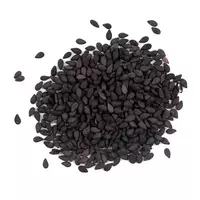Chernushka sowing (kalindzhi)

Cumin refers to fairly common and widely used spices in many culinary traditions of the world. However, in our latitudes, Cumin ordinary or Carum carvi is more popular and in demand, the seeds of which are used as a spice when preparing a large number of both first and main dishes, as well as snacks, salads, meat and sausages. Asian food makers give their preference to black cumin or kalinji.
Sowing nigella or kalindzhi (Nigella sativa) belongs to the Buttercup family. The plant is cultivated in many parts of the planet Earth and is used as a spice, as well as to obtain the famous black cumin vegetable oil, the useful properties of which have been known to mankind since ancient times. In cooking, seeds of sowing nigella (kalindzhi) are used. Archaeologists have found spice in the excavations of the pyramids of ancient Egypt.
Krmoe, the seeds of Kaliji or Chernushka sowing were found in the well-preserved and not plundered pyramid of Pharaoh Tutankhamun, who died around 1323 BC. Such historical finds indicate that the useful properties of Kalindzha or Chernushka sowing were discovered by a person back in the Era of Antiquity and the Ancient World. Historians also assure that there is a mention of the useful properties of Kalinji (sowing chernushka) in the Old Testament, which was created in the period from the 13th to the 1st century BC.
The birthplace of the chernushka sowing plant (Kalinji) is considered to be the region of Southwest Asia, and besides the Mediterranean. Currently, sowing nigella (kalindzhi) is cultivated on an industrial scale in order to obtain plant seeds that are used in cooking as a spice and natural material for producing vegetable oil. In its appearance, the sowing nigella (kalindzhi) is a plant that rarely exceeds 30 centimeters in height.
The sown nigella blooms from May to August, then fruits are formed that look like a box, inside which there are kalindzhi seeds. Interestingly, the seeds of the seed seed resemble onion seeds in their appearance. However, the taste of Kalinji seeds has nothing to do with onion taste. The useful properties of Kalinji are primarily due to the vitamin-mineral composition of the plant. The chemical composition of the inoculum contains up to 40% fatty vegetable and essential oil. Krmoe, the green leaves of Kalinja contain ascorbic acid.
Black cumin or kalinji vegetable oil has a distinctive strong spicy smell. In cooking, Kalinji seeds are most often used as a spice in the production of confectionery and drinks. It is worth noting that kalindzhi seeds can replace black peppers, and the plant does not irritate the mucous membranes of the human gastrointestinal tract. In medicine, inoculum is used to treat diseases of the respiratory system, kidneys, intestines, liver, and also the cardiovascular system.
sowing nigella (kalindzhi) 0.1 kCal
Energy value of inoculum (kalindzhi) (Ratio of proteins, fats, carbohydrates - ju):
Proteins: 0 g (~ 0 kCal)
Fats: 0 g (~ 0 kCal)
Carbohydrates: 0 g (~ 0 kCal)
Energy ratio (b | y): 0% | 0% | 0%
 Español
Español Français
Français Português
Português Русский
Русский 简体中文
简体中文 繁體中文
繁體中文 日本語
日本語 한국어
한국어 العربية
العربية Türkçe
Türkçe Қазақ
Қазақ Deutsch
Deutsch Italiano
Italiano Українська
Українська
